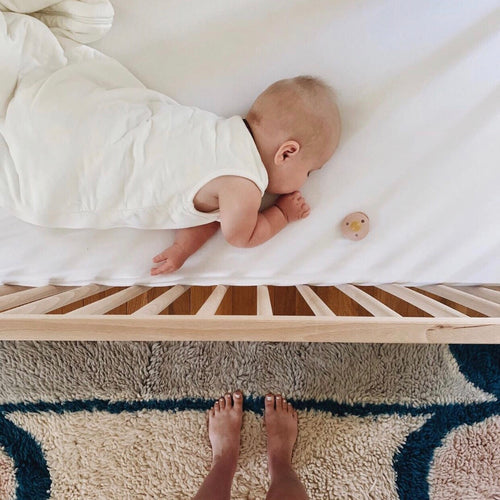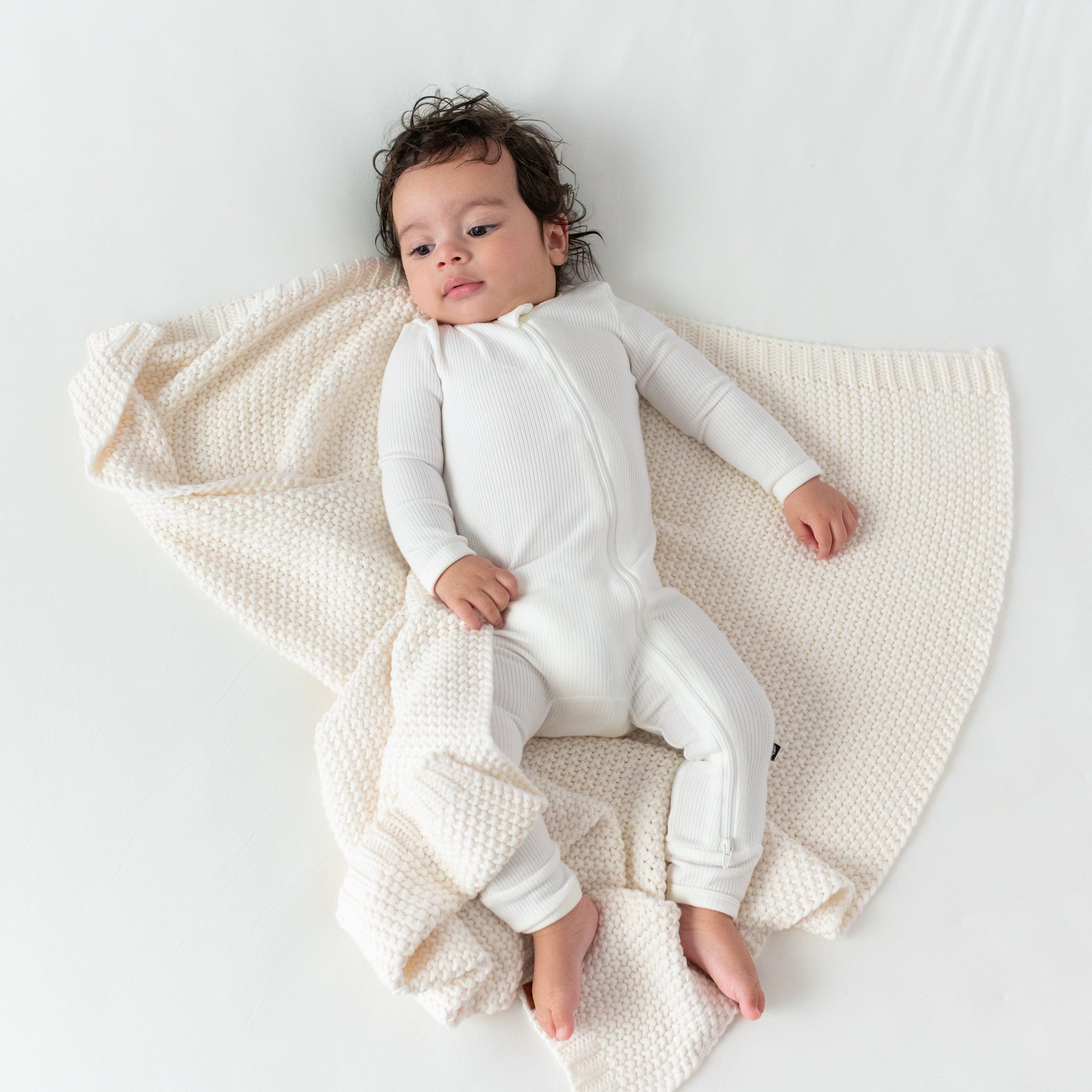Having a predictable and consistent bedtime routine is one of the most important aspects in a healthy sleep foundation! Babies thrive on routine and while everything is changing around them (like when their daily routine is different or they are learning a new skill), then having predictable routines will add calm to their chaos.
How Important is a Newborn Bedtime Routine?
Putting your little one to sleep is not always easy. But the good news is that a good night’s rest actually starts before falling asleep-- with the baby bedtime routine.
Babies actually learn through routine and action more than they learn from your words. They learn through body language and cues from their environment. This is why using sign language is so helpful for communication!
Bedtime Routine Signals Sleep
According to the National Sleep Foundation, “Sleep associations are incredibly strong." The repetitive nature of a parent’s exact actions before bed—in my case: talking in a soft voice, my son saying “goodnight”, closing the bedroom door, closing the blinds, and turning on the sound machine in the same order every night—is very powerful.
It doesn’t matter that there’s no massage or books (we read every morning instead), what matters is that we created a reliable set of steps before bed that cue her brain and body that it’s time to sleep.
As a colleague of mine says, “You could stand on your head as the first step in your bedtime routine, as long as you do it every night. The power of a bedtime routines is not in what you do, but how you do it. I keep my energy and voice calmer and move more slowly; both my kids pick up on this. That wind-down period starts 15-30 minutes before their actual bedtime routine begins. You can’t go-go-go and then plop your child in bed—the lead up time to sleep is really important.”
Establishing a Bedtime Routine and Why it is Important
First, a routine can help your baby sleep better! This wind down sequence provides an opportunity for them to transition from playing to sleeping.
Second, they help you relax too! Babies have mirror neurons which means they can pick up on any stress or anxiety you are feeling. If you are calm and relaxed, this helps them remain calm and relaxed as well.
Benefits of a Newborn Bedtime Routine
There is also a ton of great research available about the benefits of a bedtime routine plus what it should include.
“This paper presents a conceptual model and reviews the empirical evidence to support a nightly bedtime routine as a key factor in the promotion of not only healthy sleep, but also of broad development and wellbeing in early childhood.
A bedtime routine embodies the characteristics of nurturing care and early child stimulation, which are deemed to be essential for positive outcomes, especially for at-risk children.
Does a Bedtime Routine Help Development?
Furthermore, common, adaptive components of a bedtime routine can contribute to an array of positive developmental outcomes beyond improved sleep, inclusive of language development, literacy, child emotional and behavioral regulation, parent-child attachment, and family functioning, among other outcomes.”
More research about a baby bedtime routine suggests, “These results indicate that sleep disturbances in infants and toddlers can be quickly ameliorated within just a few nights after implementation of a consistent bedtime routine, including a bath with all the bathtime accessories, massage, and quiet activities.
Future research should consider the potential mechanisms behind these relatively fast improvements in sleep, such as reduced household chaos or physiological changes (e.g. core body temperature, cortisol).”
Infant Massage in the Bedtime Routine
Incorporating infant massage into your nightly routine, “resulted in improvements in child and mother night wakings, maternal perceptions of child sleep and mood (ie, sleep problem, bedtime ease, and morning mood), and improvements in maternal sleep quality.”
This study even found that adherence to a bedtime routine predicted an increase in nightly sleep minutes over a 6-month period.
Structure Through a Newborn Bedtime Routine
Implementing a baby bedtime routine can provide structure and organization to your day, especially when you have older children as well or before you are returning to work. It is a great way to reconnect at the end of a long day away!
Predictable baby bedtime routines can serve as a conditioning cue for children that “sleep is coming” and cause their body to naturally begin to wind down and feel sleepy. Just as with Pavlov’s dogs whose mouths salivated when they heard the bell, your little one is likely to start feeling drowsy when they are conditioned to know that sleep will soon be following reading books while cuddling in bed with the lights low.
In turn, this makes bedtime easier and calmer for everyone!
Reading Baby Cues to Start Your Routine
Did you know that according to Secrets of Baby Behavior, “by six to eight weeks, babies show clear signs that they can predict what will happen during feeding, social, and naptime routines. They will move their legs and arms and coo excitedly when they anticipate food or fun and turn or arch away when they know something not so fun is about to happen (like a diaper change for those who don’t like them).”
Routines will help babies know what is coming which means they will accept sleep more, feel safer so they are more relaxed, and more relaxed equals better sleep.
When Should You Start a Baby Bedtime Routine?
Research from Jodi Mindell found that, “having a regular nightly bedtime routine is associated with improved sleep in young children, and suggests that the more consistently a bedtime routine is instituted and the younger started the better.”
To promote health and to prevent and manage sleep problems, “the American Academy of Pediatrics (AAP) recommends that parents start promoting good sleep hygiene, with a sleep-promoting environment and a bedtime routine in infancy, and throughout childhood.
Thus, counseling families on sleep requires an understanding of sleep regulation, physiology, developmental patterns, optimal sleep duration recommendations, and the many factors that influence sleep and sleep hygiene.”
Creating a baby bedtime routine can help alleviate those “baby witching hours” too!
Should the baby bedtime routine stay the same every night? More research says “indicated that toddlers experienced different bedtime routines and exhibited differences in parent reported sleep duration between weeknights and weekends. Results suggest that keeping consistent bedtime routines between weeknights and weekends is important for optimal sleep outcomes.”
So, the younger the better! As soon as you come home from the hospital, you can start to provide the simple series of events that occur leading up to bedtime. Young babies pick up on patterns very quickly.
How to Create a Bedtime Routine for Baby
According to one of the studies linked above, “These bedtime routine components include activities in the broad domains of nutrition (e.g., feeding, healthy snack), hygiene (e.g., bathing, oral care), communication (e.g., reading, singing/lullabies) and physical contact (e.g., massage, cuddling/rocking).”
So a baby bedtime routine would include:
- a feeding
- a bath/wipe down and other hygenic tasks
- books, singing, prayers, talking about your day, saying good night to objects and family
- meeting their physical connection needs at the end of the day with cuddles, rocking, massage, etc!
Bedtime Routine Starting with Feeding
Let’s start with nutrition! With the exception of very young babies, we all tend to go longer at night without eating than we do during the day. So making sure they get in a good feeding before bed (or a snack for an older child) is a good thing!
Doing the feeding in a common area while they are awake can help them take in a full feeding.
Bathtime Before Bed
For hygiene, a lot of families will give a bath every day. You do not have to do that or there may be instances where that is not advisable. However, the rising body temp while in the bath and subsequent cooling after the bath speeds up the release of sleep hormones!
Reading Books During Bedtime Routine
For communication, it is very beneficial to have books in your routine, from a very early age for early literacy skills-- but it does not have to be the same book every night! Change it up, for your sake.
Snuggling to Signal Time for Sleep
Finally, physical contact could be snuggling, rocking, a quick kiss and cuddle, whatever works for your little one!
A routine does not have to be long and drawn out (and you may find that the longer it is, the less relaxing it is, not more). It should take maybe 30-45 minutes max from start to finish!
I have been told before that parents “tried a routine, it didn’t work.” Which usually means it did not fix their sleep or make their child sleep perfectly over night. But it is a big part of the puzzle in improving sleep!
All of the parts build their sleep associations for good sleep hygiene. At the end of the routine, adding in a sleep bag will help them feel cozy, just like getting tucked into bed!
What if Baby Requires Help Falling Asleep?
But wait, when is the part where we put them to sleep? If assisting to sleep works for your family and you are all rested, then do what works for you!
Research shows that a main predictor in struggling to fall asleep with the combination of frequent night wakings is having assistance falling asleep or parental presence when falling asleep. If they need you at the beginning of the night, they will be calling for you to help them back to sleep when they have those biologically normal wakings!
Sleep coaching would never take those wakings away, they just give them the skills to return to sleep if that is all they are needing. If you are interested in sleep training or you are wondering what is sleep training, then that link will give you more information!
If you are wondering about if a baby bedtime routine would help your little one sleep through the night, then you can read all about that in our blog about sleeping through the night!
Should swaddling be a part of your bedtime routine? Potentially, if they are young enough! If you do not know how to swaddle a baby, then our blog can give you all of those details.
If you can avoid, screen time in your bedtime routine! Deep breathing activities from an app or some calming music is totally fine. We just know that the blue light emitted from screens can negatively impact our sleep hormones. However, you can totally get all those giggles out! Fun fact: laughing in the evening increases melatonin production!
Baby Bedtime Routine Example and Bedtime Routines by Age
Let’s talk about a bedtime routine for a newborn! Keep in mind they are only awake for a short period of time (more info about baby sleep schedules here) so it will not be a very long routine.
It might consist of:
- Feeding/Burping
- Diaper/Jammies
- Turning off the lights/turning on white noise
- Swaddle
- Rock/bounce/sway
- Put them down asleep, drowsy, or awake (whatever works for them!)
Baby Bedtime Routine: 2 Months Old
Two-month-old babies have an awake time of about 60 minutes.
- Feeding/Burping
- Bath + Lotion Massage
- Diaper/Jammies
- Turning off lights/turning on white noise
- Putting them in their sleep bag (if they are big enough for it!)
- Rock/Cuddle
- Put them down asleep, drowsy, or awake
Baby Bedtime Routine: 5 and 6 Months Old
Babies 5-6 months old have an awake time before bed of about 2-2.5 hours.
- Solids, potentially or feeding/burping
- Bath + Lotion Massage
- Diaper/Jammies
- Read 1-2 books/board books/let them play a little
- Put on their sleep bag
- Sing a quick song
- Kiss and cuddle
- Into crib awake
Bedtime Routine For a Toddler
This routine can be incorporated into a visual chart to help keep everyone on track!
- Dinner
- Bath + Lotion massage
- Brush teeth
- Potty
- Pajamas
- Lights down
- Read 2-3 books
- White noise on
- Songs
- Good night words and leave the room
Bedtime Routine with Multiple Kids
- Joint bath and teeth brushing
- Pajamas laid out for the older kids while you dress the younger kid
- Books together
- Each parent can take a child to tuck them in now OR if you are solo parenting, I recommend getting the baby down first while the oldest does a puzzle, builds something, reads books in their room, etc
It is so beneficial to have an older sibling involved in the baby’s bedtime routine. It provides some responsibility and togetherness at the end of the day.
If each parent is taking a child, switch off every few nights so the oldest will get 1:1 time with each parent and the youngest one does not start to have a preference for who puts them to bed!
Parental Involvement in the Bedtime Routine
Parental (especially dad) involvement in bedtime routine has positive effects according to this study. They found, “The main results of this study emphasized the protective role of consistent bedtime routines and bedtime paternal involvement in reducing infants' bedtime difficulties perceived both from mothers and fathers.”
Keep Some Flexibility in Your Routine
If you are busy and lose track of time, you can definitely drop anything “nonessential.” So skip the bath, skip the books, and shorten the cuddles if you need to.
If you do a bedtime snack for your toddler, I suggest something like peanut butter, or cheese. Something higher in fat/protein as opposed to fruit. Sugar, even natural sugars from fruit can interrupt our sleep hormone production.
Does bedtime have to be at the same time every night? No, however, we do not want a vast difference from night to night. A 30-60 minute window is within the realm of normal depending on naps and activities for that day.
Baby Bedtime Routine Takeaways
We are all creatures of habits! We all have our own routines and preferences. Some like the sheets tucked in nice and tight, others prefer to have their feet free and dangling off the bed. How can you tell if your routine is working for you and your child? Take note of how you feel during the routine (happy or stressed?) and how easily your child moves from one task to another.
It is okay to change it up if it is becoming a stressful time for both of you! Maybe reading books at bedtime makes them scream-- it is okay to skip that part and read books during the day instead.
If you decide that you cannot read books every night with your toddler because it becomes a battle, then skip the books and tell them a funny story about when they were a baby or when you were a kid! You can also incorporate photo albums instead of books for your stories. Maybe they hate bath time and are really unhappy after their bath. You can bathe in the morning instead!
The most important takeaway is that you build a consistent routine around sleep that evolves as your child gets older. You also want to make sure it is something you can maintain.
If you are wondering about how to create a nap routine, it can just be a simplified version of your bedtime routine! You would not bathe multiple times a day, usually (if you do though, that is cool), but a quick lotion and massage, book, white noise, sleep bag, song/cuddle, and down for their nap.
Dos and Don’ts for the Bedtime Routine
- Do start early! Whenever you want, it is never too early or too late.
- Make it age appropriate (a newborn would be swaddled, but not an older infant!)
- Make it fairly short, not long and drawn out which can lead to stalling (but may also be overstimulating instead of relaxing if it is too long)
- Consider offering a lovey when they are older than 12 months
- Be consistent (I know, I know)
- Considering offering some choices for your older child (pick out their own pajamas or books)
- A night light is okay for an older child who is asking for one
- Dental hygiene is important, even if they do not have teeth yet! Wipe their gums with a Kyte Baby washcloth, especially after starting solids to make sure they are not pocketing any food, but it also keeps them familiar with you doing some form of oral care
- Consider using a sleep bag as a positive sleep association (not to mention that it can help temperature regulation which being too hot or too cold can cause extra wakings!)
- Try to make their room a familiar place; if your child is always crying through the routine, this is not necessarily a bad thing because it means they have formed a sleep association, but we want to teach them that their room is an okay place to be! Try to play in their room throughout the day outside of sleep times, same with their crib! 1-2 minutes of tummy time in the crib during the day can really add up overall
- Avoid stimulating tasks before bed like wrestling, TV or video games
- No caffeine before bed (do kids drink caffeine? Either way, steer clear!)
- Do not assume that just a bedtime routine will fix poor sleep-- it is an important part we want to have in place, but not the whole puzzle!
- Do at least some of the routine in their room, and once you are there try not to leave and go back. Each step of the routine should be leading them closer and closer to their bed at the end of the night.
Most importantly, do not stress if you have a new baby at home and you have not started a “routine” yet. You can start whenever you are ready and feel comfortable doing so.
Author Bio: Ashley Olson is a certified pediatric sleep consultant, owner of Heaven Sent Sleep, and passionate about helping new parents, experienced parents, desperate and sleep-deprived parents form healthy sleep habits for their children.She has over 3 years of experience in working with families and has completed over 150 hours of coursework plus continuing education related to infant and toddler sleep. The focus of her work is on fostering a routine that grows your bond with your child while improving their sleep habits. She specializes in custom sleep plans and one on one support in changing sleep practices!



















